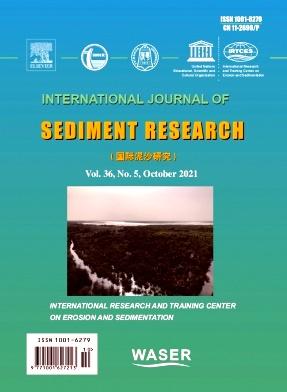Mechanisms of debris-flow volume growth by eroding highly-consolidated landslide dams
IF 3.5
2区 环境科学与生态学
Q2 ENVIRONMENTAL SCIENCES
引用次数: 0
Abstract
Erosion of landslide dams by a natural debris flow as it travels down a sloping channel can dramatically increase flow size and destructive potential. Most research on the erosion of landslide dams focuses on those newly formed due to recent earthquakes or heavy rainfall. In this study, the debris-flow erosion of so-called highly-consolidated landslide dams (HCLDs) that are typically remnants of ancient earthquakes or rainfall events is investigated by using satellite image interpretation, field measurements, and mechanism analysis. Several HCLDs were identified in two catchments in Zhouqu and Ganluo counties in Gansu and Sichuan province, China, where two high-magnitude debris-flow events occurred in 2010 and 2020, respectively. The existence of HCLDs resulting in wide and narrow reaches alternatively alters the boundary conditions of debris flows and significantly affects the flow erosion and deposition processes. It is observed that the flow discharge increased notably after passing through or during narrowing sections of the channels and the estimated discharge amplification coefficients are approximately 3.3 and 2.7, respectively. The two cases demonstrate that rapid erosion through narrowing sections and subsequent headward erosion play a key role in the debris-flow volume growth by eroding HCLDs. Additionally, other mechanisms such as deposition of erodible material upstream of the dam, localized vortexes in converging and diverging sections, and collisional stresses within the debris flows can further contribute to the erosion of HCLDs and the amplification of debris-flow magnitude. Recognizing these hazardous effects of HCLDs on increasing debris-flow volume is helpful for making non-structural and engineering countermeasures against similar debris flow disasters.
高固结滑坡坝侵蚀泥石流体积增长机理
天然泥石流沿着倾斜的河道而下,对滑坡坝的侵蚀会极大地增加水流的大小和破坏潜力。大多数关于滑坡坝侵蚀的研究都集中在那些由于近期地震或强降雨而新形成的滑坡坝上。在本研究中,利用卫星图像解译、现场测量和机制分析,研究了所谓的高固结滑坡坝(HCLDs)的泥石流侵蚀,这些坝通常是古代地震或降雨事件的残留物。在2010年和2020年分别发生过两次高震级泥石流事件的甘肃省舟曲县和四川省甘罗县两个集水区发现了若干高震级泥石流。高裂缝的存在导致河段宽窄交替变化,改变了泥石流的边界条件,显著影响了水流侵蚀和沉积过程。结果表明,通过通道后或通道变窄段时,流量显著增加,流量放大系数分别约为3.3和2.7。这两个例子表明,通过狭窄断面的快速侵蚀和随后的向内侵蚀在侵蚀高分段砾岩的泥石流体积增长中起着关键作用。此外,大坝上游可蚀物质的沉积、汇流段和分流段的局部涡旋以及泥石流内部的碰撞应力等其他机制也会进一步促进高滩的侵蚀和泥石流强度的放大。认识到HCLDs对增加泥石流量的危害作用,有助于制定针对类似泥石流灾害的非结构和工程对策。
本文章由计算机程序翻译,如有差异,请以英文原文为准。
求助全文
约1分钟内获得全文
求助全文
来源期刊
CiteScore
6.90
自引率
5.60%
发文量
88
审稿时长
74 days
期刊介绍:
International Journal of Sediment Research, the Official Journal of The International Research and Training Center on Erosion and Sedimentation and The World Association for Sedimentation and Erosion Research, publishes scientific and technical papers on all aspects of erosion and sedimentation interpreted in its widest sense.
The subject matter is to include not only the mechanics of sediment transport and fluvial processes, but also what is related to geography, geomorphology, soil erosion, watershed management, sedimentology, environmental and ecological impacts of sedimentation, social and economical effects of sedimentation and its assessment, etc. Special attention is paid to engineering problems related to sedimentation and erosion.

 求助内容:
求助内容: 应助结果提醒方式:
应助结果提醒方式:


